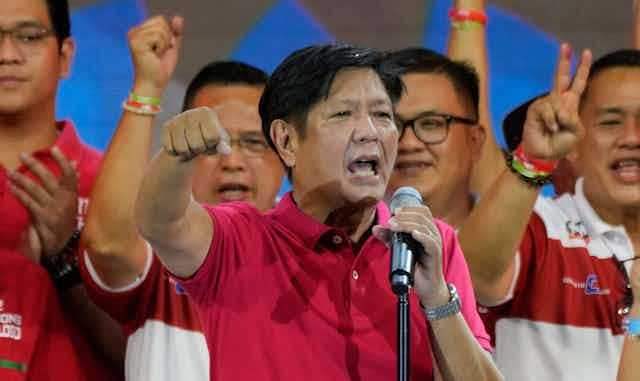Ferdinand Marcos Jr. has been elected the 17th president of the Philippines, 36 years after his father, the known dictator and plunderer Ferdinand Sr., was ousted in a peaceful revolution.
Marcos Jr. won the presidency with 31 million votes, trouncing his closest rival, Vice-President Leonor “Leni” Robredo, who received 15 million votes.

Ferdinand Marcos Sr. established martial law in the Philippines from 1972 to 1981, a period of brutal repression with more than 11,000 documented human rights violations. Critics of Marcos were imprisoned, tortured, raped and executed. His family and their cronies are thought to have plundered about $10 billion, and they evaded legal claims for the Marcos family’s ill-gotten riches in Philippine and foreign courts even after Marcos Sr.’s death in Hawaii in 1989.
Critics accuse the Marcos family of whitewashing their family’s crimes and martial law atrocities through social media platforms. In a narrative of denial, Marcos Jr. promises to restore the “Golden Age” of peace and prosperity that his father had begun, raising questions about whether that means a future of martial law.
Revisionist history
The revisionist “narrative of nostalgia” has three parts, according to Filipino academic Victor Felipe Bautista:
The supposed glorious past under a benevolent President Marcos;
The fall that interrupted the Marcos regime supposedly orchestrated by Corazon Aquino, the widow of Marcos’s political arch-rival, Benigno Aquino Jr., who was assassinated on the Manila airport tarmac upon his return to the Philippines in 1983;
The dark present, when Marcos is said to be a “victim of black propaganda,” meaning subtle propaganda that does not come from the source it claims to come from.
The Marcos Jr. propaganda operations include collective memory experts who use revisionist nostalgia as a tool for steering public opinion.
Critics suggest massive and well-resourced efforts to change and control the narrative through historical revisionism has been key to Marcos Jr.’s electoral victory. I complement this with a view that the Philippines’ colonial legacy equally influenced the results of the recent presidential election.
Colonial class divides
In many post-colonial societies, colonial powers and their elite, modern-day counterparts maintain class divides. Those divides allow them to control the masses as a steady source of extracted surplus and cheap labour and, for local politicians, a traditional source of votes.
Development in the Philippines has always been tied to colonial relations. Ties with the United States remained strong even after formal independence in 1946, which is evident in bilateral agreements allowing American firms to own and operate public utilities and extract natural resources.
Post-colonial relations with the U.S. and development aid helped generate the fortunes of a Filipino landed oligarchy, dispensed infrastructure and agricultural loans and provided military aid during the martial law years, setting the stage for the Marcos years as the Golden Age in Philippine history.
Returning from their exile in the 2000s, members of the Marcos family were elected to various political positions. Efforts to change the anti-Marcos narrative and alter the political culture in the Philippines via the new technologies of social media grew rampant.
Before long, photos of bridges, roads and buildings built by Marcos Sr. began to flood social media to suggest the Philippines was on par with emerging industrializing nations at the time of his administration.

“If my father was allowed to pursue his plans, I believe that we would be like Singapore now,” said Marcos Jr. in 2011.
Western appeal
To young voters born after the martial law era — the country’s largest voter demographic — Singapore evokes images of globalized progress: glitzy designer malls, savvy digital technology and western-style posh lifestyles that promote capitalist consumption. Young Filipino voters also seemed to delight in the “cool” Marcos vibe of speaking with American accents and stories of the privileges that come with wealth.
The Marcos messaging — also carefully curated in more than 200 BuzzFeed-style posh, familial and cheerful YouTube videos — sought to temporarily bridge the traditionally sharp social divides in the Philippines. This served to momentarily placate centuries-old internalized local racism, self-othering and a deep-seated sense of colonial, racial and class inferiority among Filipinos compared to westerners and their local wealthy counterparts, such as the Marcos family.
For a deeply class-stratified and colonized society, the Marcos propaganda machine has enhanced aspirations for western markers of progress and modernity.
But these efforts haven’t just been an attempt to whitewash the plunder of the Marcos family and the brutalities of martial law.
The propaganda also conjures up a vision of a neocolonial, modernized and consumption-driven future. In a nutshell, Marcos has escalated western aspirations and solidified the racialized and marginalized class identities that capitalism — an economic system organized around a minority class and its pursuit of profit — is dependent upon.
Marcos Jr.’s references to a Golden Age in the Philippines invites a nostalgic look at the past. But it also warns of a darker future.

